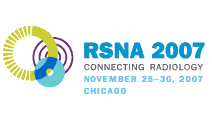
Abstract Archives of the RSNA, 2007
LL-BR2127-H08
Breast Cancer of Women in Their Twenties: Multimodality Imaging Characteristics and Pathologic Correlations
Scientific Posters
Presented on November 27, 2007
Presented as part of LL-BR-H: Breast Imaging
Ann Yi MD, Presenter: Nothing to Disclose
Hak Hee Kim MD, Abstract Co-Author: Nothing to Disclose
Hee Jung Shin MD, Abstract Co-Author: Nothing to Disclose
Hyunsoo Kim MD, Abstract Co-Author: Nothing to Disclose
Mi Ock Huh MD, Abstract Co-Author: Nothing to Disclose
Min Jeong Kim MD, Abstract Co-Author: Nothing to Disclose
To evaluate the clinical, imaging, and pathologic findings of young-aged breast cancer for women in their twenties.
Among 4706 patients with biopsy proven breast cancer in a 5 year period, 155 patients were included who diagnosed malignancy on twenties(mean, 27.6 years; range, 20-29 years). Three radiologists retrospectively reviewed available images including mammography(n=111), ultrasonography(n=126), and MRI(n=9) according to the Breast Imaging Reporting and Data System lexicon. And then, medical charts and pathologic outcomes of all patients were also reviewed.
Almost all patients were symptomatic(n=154) and painless lump was the most common complaint(n=123, 79.4%). Eleven patients(7.3%) had familial history of breast cancer. Mean tumor size was 2.6 cm(range, 0.1–13.5 cm) and 134 tumors(86.5%) were palpable. Common imaging features were as follows: mass or focal asymmetry without microcalcifications(n=47 of 111, 42.3%) on mammography; a mass(n=113 of 126, 89.7%) with an oval to round shape(n=60 of 113, 53.1%), indistinct-margin(n=56 of 113, 49.6%) on ultrasonography. On nine dynamic contrast-enhanced MRI, enhancing masses in 4, non-mass like enhancements in 4, and enhancing foci in 1, which showed rapid enhancement and delayed washout pattern in all cases. BIRADS categories of 155 cases were III(n=19, 12.3%) , IV(n=62, 40.0%), and V(n=74, 47.7%). False negative results were in 21 patients(18.9%) on mammography, 1(0.8%) on ultrasonography, and 0(0%) on MRI. Histology revealed invasive ductal carcinoma in 124 patients(80%), ductal carcinoma in situ in 18(11.6%),and malignant phyllioides tumor in 3(1.9%).On immunohistochemisty, estrogen and progesterone receptor positivities were in 73(52.9%) and 57(41%)cases. P53 and Her-2 positivities were in 39(30.0%) and 75(54.3%).
Young-aged breast cancer commonly menifests as a palpable mass with some benign favored features on ultrasonography. False negative rate was high on mammography.
MRI was the most reliable imaging modality for young patients who was clinically suspicious malignancy with vague imaging features on US and mammography.
Yi, A,
Kim, H,
Shin, H,
Kim, H,
Huh, M,
Kim, M,
Breast Cancer of Women in Their Twenties: Multimodality Imaging Characteristics and Pathologic Correlations. Radiological Society of North America 2007 Scientific Assembly and Annual Meeting, November 25 - November 30, 2007 ,Chicago IL.
http://archive.rsna.org/2007/5004417.html

